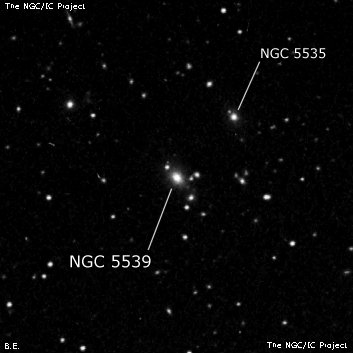
John Herschel discovered NGC 5539 = h1767 on 24 Apr 1830 and recorded "F; irreg fig; pL; gbM; r." His position matches PGC 51054, the brightest member in the distant cluster AGC 1890. NGC 5535 (discovered by Marth) is 2.4' northwest, although CGCG (046-084) and MCG (+01-36-033) equate NGC 5535 with 5539. At a distance of ~780 million light years (z = .057), this is one of the most distant galaxies in the NGC, along with NGC 870 and NGC 2603, according to Wolfgang Steinicke.
400/500mm - 17.5" (7/18/01): faint, small, 0.5'x0.3', elongated SW-NE. A faint star is attached at the NE end. Irregular surface brightness and shape. This galaxy is identified as NGC 5535/5539 in MCG and CGCG although NGC 5535 is a separate galaxy 2.4' NW (also observed). At a distance of ~780 million light years (z = .057), this is one of the most distant galaxies in the NGC.
17.5" (5/15/99): this galaxy is the brightest in AGC 1890 and appeared surprisingly faint and small. Very faint, very small, 20" diameter, irregular appearance - appears to have a faint star involved or the galaxy may be double. On the DSS there are several faint stars and/or stellar companions very close. NGC 5535 is 2.4' NW (not seen).
900/1200mm - 48" (4/19/17): at 610x; moderately bright, fairly small, slightly elongated SW-NE, 24"x 18", small bright core. A mag 15.5 star is barely off the NE edge of the halo. NGC 5539 is the brightest cluster member of AGC 1890. Several fainter companions are nearby, the closest 3 form the quartet Rose 20.
LEDA 1340691 (V = 16.0), 0.7' SW: faint, very small, round, 10" diameter.
2MASX J14173546+0810518 (V = 16.5), 0.6' W: fairly faint, very small, round, 10" diameter.
LEDA 1340894 (V = 16.3), 1.8' W: extremely to very faint, round, 6"-8" diameter.
2MASX J14173411+0813258 (V = 16.1), 2.8' NNW: very faint, extremely small, round, 8" diameter.
LEDA 1342289 (V = 17.2), 3.2' N: extremely faint and small, 5" diameter.
LEDA 1341835 (V = 15.3): faint to fairly faint, small, round, 12"-15" diameter.
Notes by Steve Gottlieb